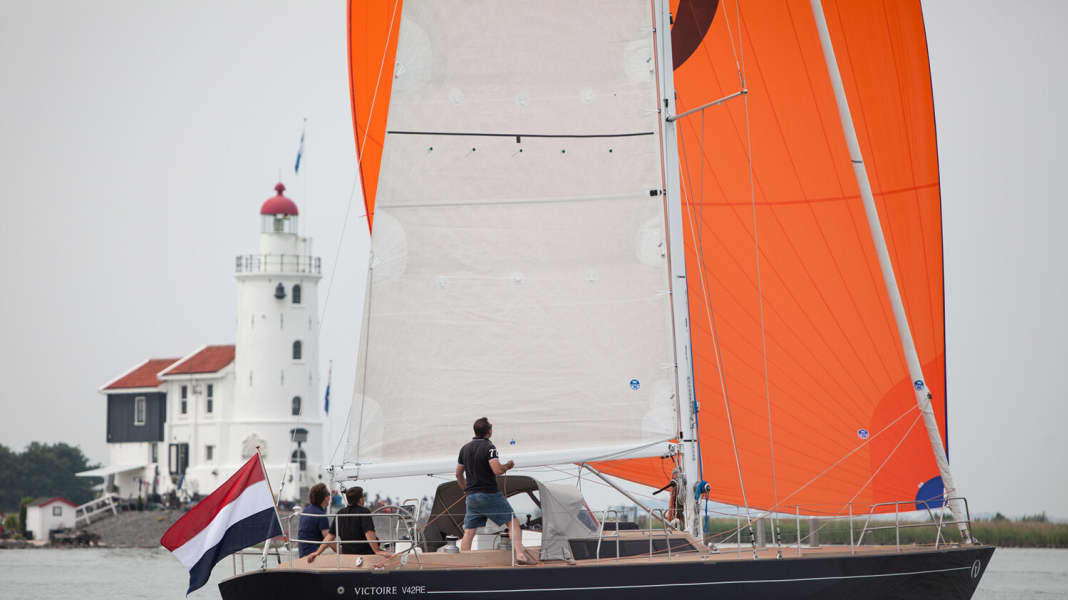
ARRIVAL
The region around the IJsselmeer is popular because it is easy to reach by car or train. Sailors from North Rhine-Westphalia and western Lower Saxony in particular, but also from Hesse and Rhineland-Palatinate, can be there in just a few hours. This is environmentally friendly and has the advantage that you can bring your provisions with you on the way, whereby the supermarkets in the Netherlands also offer attractive products such as Vla (vanilla pudding in a tetrapak), Stroopwaffels (caramel biscuits) or all kinds of food with an Indonesian background.
You should find out briefly at the charter station where the car can be parked for the duration of the trip - this is usually possible on the marina grounds or in the surrounding area, usually free of charge. As in Germany, free parking is otherwise only possible in many places for a fee or for a short time. Prohibitions should be obeyed at all costs, the fines in Holland are significantly higher than in Germany. Incidentally, the same also applies to obeying the speed limit. Please note: From March 2020, the speed limit on motorways will be 100 km/h during the day (6 am to 7 pm).
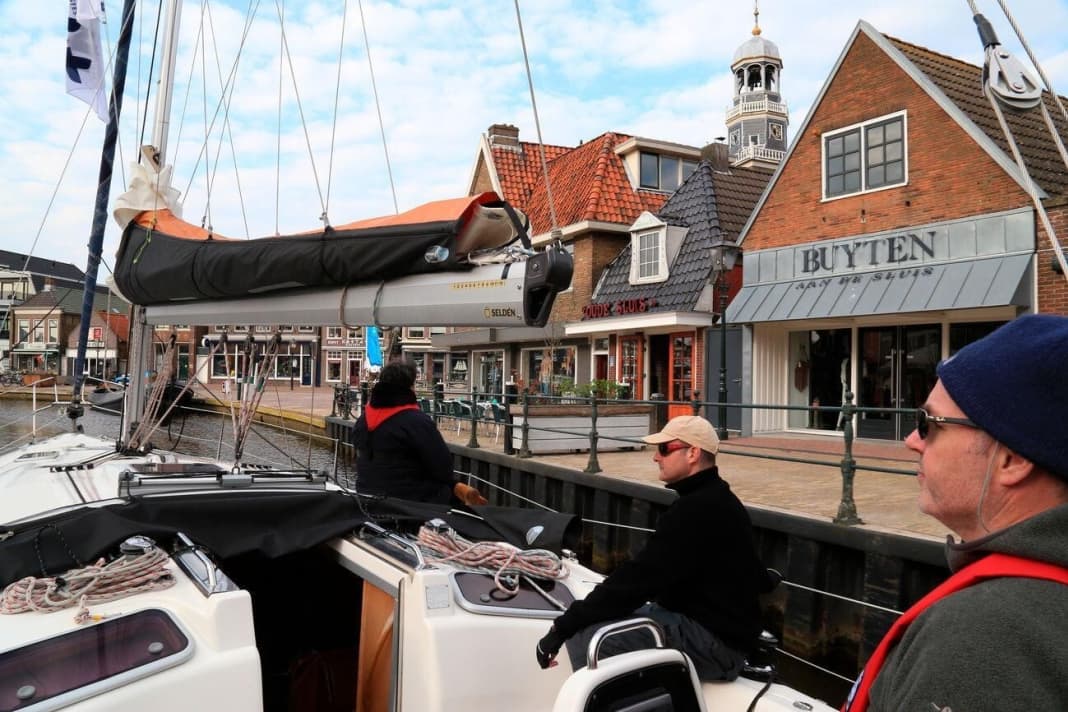





CHARTER
There is a wide range of charter fleets on offer. The charter hotspot is clearly Lemmer with several large bases. However, Lelystad, Stavoren, Workum and Enkhuizen also offer ships of varying quality and therefore more or less favourable prices. Ultimately, it is advisable to choose the base according to the destination you are travelling to. If you are heading for the islands in the Wadden Sea, it makes sense to choose a base further north. If you want to visit the Markermeer with the small towns of Hoorn, Edam, Monnickendam and Amsterdam, you may want to charter further south. In Monnickendam, a special offer awaits customers with the Waterland fleet: Very well-equipped yachts from Dehler and X-Yachts and even a Dragonfly trimaran are waiting for customers there. The latter should only be hired with experience and a previous training weekend. The IJsselmeer and Markermeer are not recommended for boats under 25 feet.
The charter prices in Holland are favourable, in Europe they are only comparably low on the Baltic Sea. Very popular with customers, but not so popular with providers, is the option of chartering for just a weekend or over public holidays, which is much more common in the Netherlands than elsewhere, but is not offered by all charter companies. A boat with heating is highly recommended, as it can get quite cold even in summer. The heat source also helps if oilskins need to be dried. A dinghy is not necessary as you are always moored in harbours. Some companies offer gennakers; if you can handle them, you're sure to have fun.
WIND & WEATHER
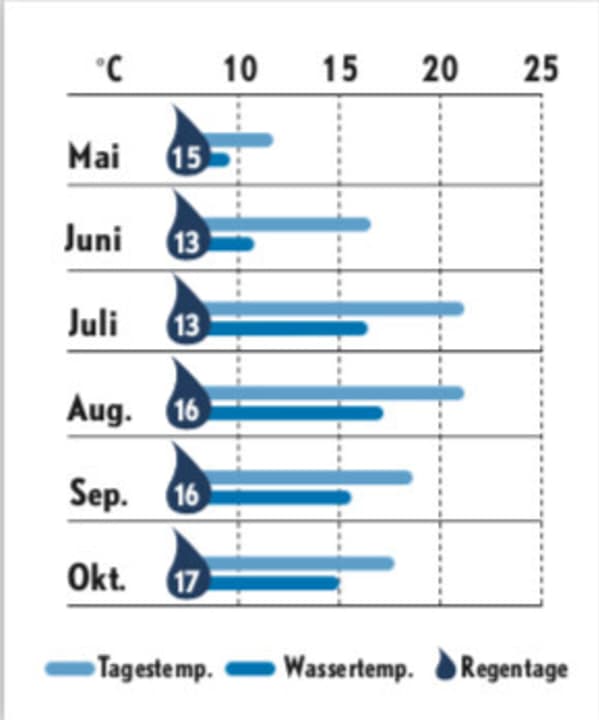
Just like the German coast, the Dutch inland sea is known for its unpredictable summers, even if super summers like 2018 have become more frequent in recent years. From April to the beginning of September, winds from south-westerly to westerly directions dominate the scene. They blow around one Beaufort weaker on the IJsselmeer and Markermeer than directly on the coast, with an average of 10 to 14 knots or 3 to 4 Beaufort. Days with rain are always possible, with a high probability of 13 to 20 days per month from April to October. However, thanks to the perfect tourist infrastructure on land, these days can also be spent ideally - there is hardly a destination that would not offer a perfect alternative programme in case of bad weather.
NAVIGATION & SEAFARING
The IJsselmeer is not very demanding to navigate. Apart from a few well buoyed shallows, it is sufficiently deep everywhere. The distances are manageable and sailing days often last no longer than three to four hours. The large harbours usually have space available. However, if you want to moor in a city harbour, you should not arrive too late in the high season, as it can get crowded there. Whether in Enkhuizen, Medemblik, Hindelopen, Makkum, Stavoren, Lemmer or Urk.
With westerly winds of 5 or more Beaufort, some harbour entrances on the east coast become uncomfortable, both when entering and leaving. The approach to the narrow channel of Workum is difficult, as is the entrance to Hindelopen. Stavoren can always be approached, but there can often be a confused swell before the entrance. However, this only lasts for a few hundred metres. So: hang in there.
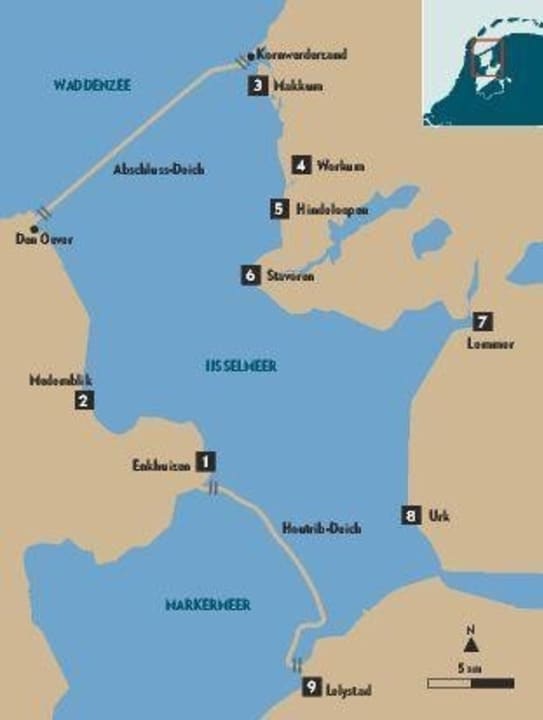
The highest waves on the IJsselmeer are measured off the Rotterdamse Hoek between Urk and Lemmer. It can also get uncomfortable there with westerly winds. The inland sea is notorious for its thunderstorm fronts. These usually approach from the south-west and bring strong winds and rain. The water then turns green and the air black. Due to the influence of the wind, the water level in the harbours, especially in Lemmer, can fluctuate greatly, up to 1.20 metres is possible. To avoid surprises caused by such weather phenomena, there is the Centrale Meldpost. It is based in the radio tower in Lelystad and broadcasts an area and weather report once an hour, always at a quarter past on channel 1. You should definitely listen to this area radio.
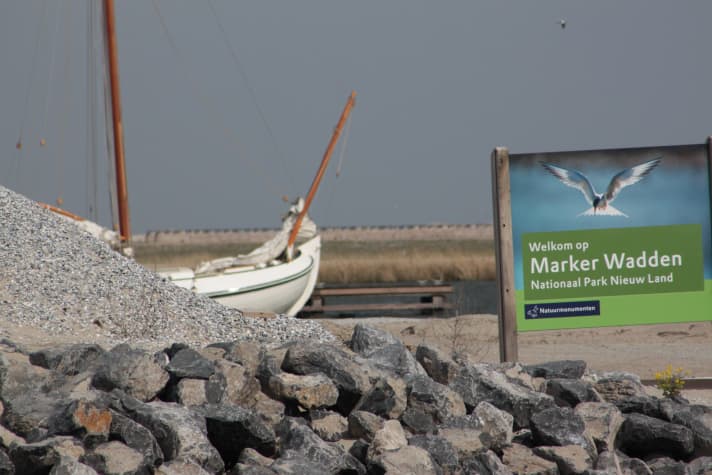
Essentially the same applies to the Markermeer as to its big brother in the north: not very demanding in terms of navigation and also sufficiently deep everywhere. However, fonteinkruid, an aquatic plant, grows in the Markermeer between June and the end of August. The growth is so pronounced that yachts regularly get caught up in it; sailing is then out of the question. The area between Hoorn and Edam should be avoided completely. Along the coast of Flevoland, the growth is less pronounced. However, fairways are regularly mowed.
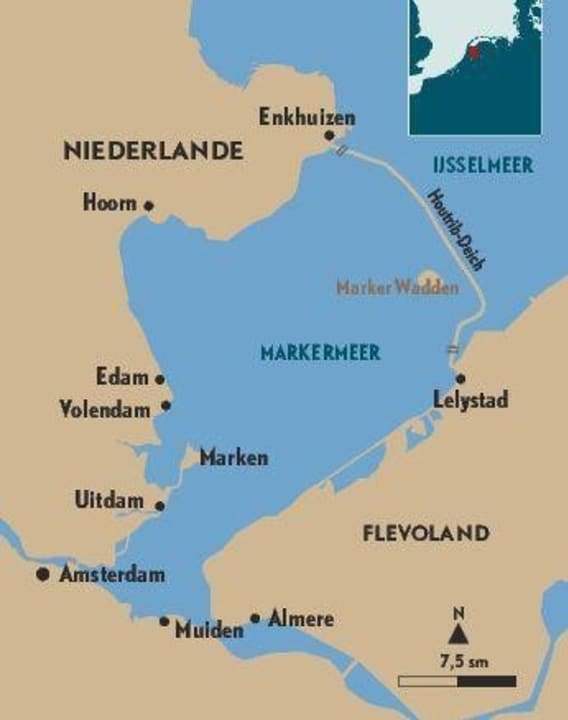
The Markermeer has two special features: the Marker Wadden in the north-east corner off Lelystad and the Gouwzee in the south-west. The former is an artificially created natural archipelago that can be visited by yachts. There is a harbour and rudimentary sanitary facilities. The operators ask you to reserve a berth via the Blue Water app. The Gouwzee is a bay on which the towns of Volendam, Marken and Monnickendam are located. All are worth a visit and can be reached with a draught of up to two metres, although Volendam and Marken are very touristy. In the Gouwzee, be sure to keep to the fairways!
If you want to visit Amsterdam, you first have to cross the Schellingwouder Bridge and the Oranjesluizen. This is no problem, but both are closed during rush hour to allow traffic to flow. On weekdays, the bridge is therefore closed between 7am and 9am and between 4pm and 6pm. Het IJ, a large river/canal, runs through Amsterdam. It has a buoyage for pleasure yachts next to the main fairway. You should keep to this. There are a whole series of harbours, starting with Entrepot Dok. Turn to port after the lock. The other harbours are all along the IJ. Aeolus to starboard, followed by the famous Sixhaven, then a little further on the Amsterdam Marina. The Westerdok marina is located next to the Central Station.
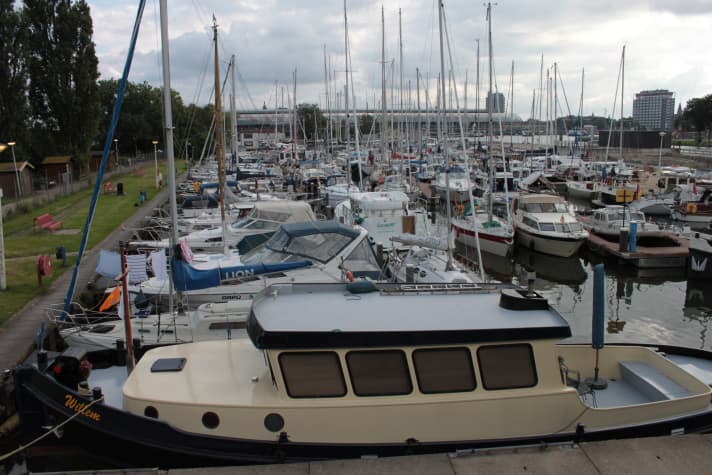
Free ferries run regularly from the harbours in the north of the IJ to the city.
Bridges and locks: There are only a few structures on the IJsselmeer and Markermeer. In the north there are the locks in Kornwerderzand and Den Oever, which lead into the Wadden Sea, and in the centre the passages in Lelystad and Enkhuizen through the Houtribdijk. To the east, the Ketel Bridge leads into the Ketelmeer. The operating times are very long and detailed information on each structure can be found in the Wateralmanak.
HARBOURS & ANCHORAGES
Many marinas. Some of the sanitary facilities are of a somewhat outdated standard, mostly pitches with fixed or floating pontoons with stern piles. Most marinas always have a place available, but you often have to register at the registration jetties. Reservations are no longer possible in most harbours. In city harbours, the rule is: first come, first served. You are often berthed in packets there; if you don't like this, it is better to avoid these facilities. Arriving early and turning away late arrivals is the worst kind of seamanship. The sanitary facilities are all okay, although not luxurious. In city harbours, the standard is often lower than in marinas.
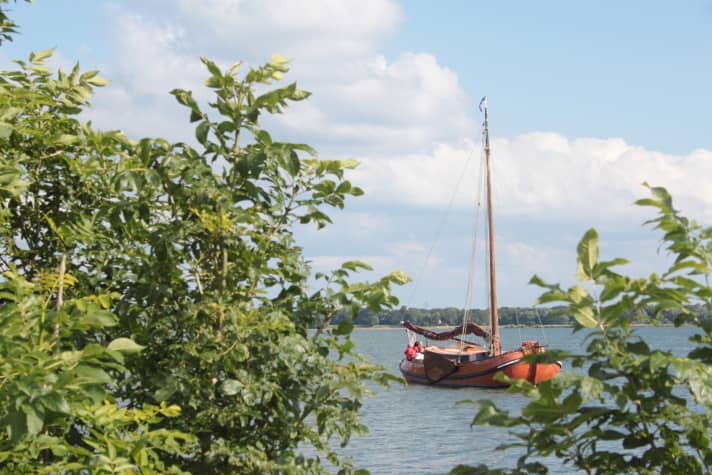
Anchoring is very rare, many charter yachts do not even have an anchor winch and often no chains. If you still want to anchor, you can do so in Makkum between the lock and the mainland, in Enkhuizen in the Compagnieshaven in front of the Zuiderzee Museum, in Medemblik at the Steam Engine Museum, in the Gouwzee, in the IJsseloog on the Ketelmeer, in front of Marina Friese Hoek in Lemmer, in the escape harbour north of Marina Muiderzand and in front of Durgerdam.
LITERATURE & NAUTICAL CHARTS
The ANWB's Wateralmanak is an indispensable reference work for every cruise. The two-volume work lists all telephone numbers, VHF channels and opening times of bridges and locks, among other things; it also contains all harbour information. Each volume costs 19.95 euros and is available from specialised dealers. Nautical charts: The ANWB charts, set 1810 IJsselmeer and Markermeer, are the most frequently used. The charts from NV-Verlag, set NL 3, 49.00 euros, are also good. Nautical information is available at www.vaarweginformatie.nl.General information on fairways, dates, activities, country and people can be found on www.stegfunk.de a portal for water sports enthusiasts in the Netherlands.
REVIER-CHARACTERISTIK IJSSEL- and MARKERMEER
The IJsselmeer and Markermeer are inland waterways that feel like real sailing. Sometimes you can't see the other side, looking at an empty horizon. The harbours are well developed, and in the old towns from the time when the IJsselmeer was still called the Zuiderzee and was open to the North Sea, the charm from the days when it still smelled of salt has survived. This makes the area a cross between inland and sea sailing. You can gain your first experience away from the coast without actually being too far away. A sheltered harbour can usually be reached within an hour. The area is therefore ideal for first attempts on big water.
But the IJsselmeer can also be different. With (south)westerly winds from 5 Beaufort, an unpleasant wave builds up. It is very steep because of the shallow water. Yachts under 35 feet will inevitably get caught in it. If you have to tack, you can expect two to three knots over the ground and a wild ride; shorter boats can't go any faster. You certainly don't want that. Fortunately, there is always an alternative harbour on a better course. It is therefore advisable not to hold on to your planned destination for too long.
A typical round could look like this:
Day 1: Lemmer to Urk, approx. 16 nautical miles
Day 2: Urk to Hoorn, approx. 25 nautical miles
Day 3: Hoorn to Enkhuizen, approx. 12 nautical miles
Day 4: Enkhuizen to Medemblik, approx. 12 nautical miles
Day 5: Medemblik to Makkum, approx. 20 nautical miles
Day 6: Makkum to Lemmer, approx. 28 nautical miles
Then you will have travelled to all the important destinations without getting really stressed. A special feature of the IJsselmeer and Markermeer is the so-called brown fleet, so called because it used to have dark (brown) sails. These are old cargo ships that have been converted into passenger ships. The captains on the ships are usually a little idiosyncratic. They are considered commercial vessels and therefore enjoy right of way on the inland waterways, which they are happy to take. It is therefore advisable to keep your distance.
The towns themselves are real gems - be it Hoorn with its cheese market, Urk with its fishing tradition, Enkhuizen as the proud former town of the East India Company or Lemmer with its lively town centre, in the middle of which you can conveniently moor right away. There is plenty to see. The short stages are therefore ideal for exploring the small towns behind the harbour.
A special feature is that if bad weather threatens, you can also flee inland to the waters of Friesland. The route continues with pretty little towns and many places of interest. They are described here.
.

